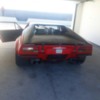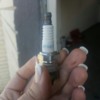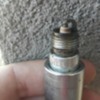quote:Originally posted by PanteraDoug:
Mine look like that as well including in my 347 Windsor.
Your plugs would indicate to me that the idle is way to heavy on your induction. The light side is about right.
This dual reading happens because one side is facing the intake valve, the other is facing the exhaust valve.
One thing that you will find as helpful is indexing the plugs. All plugs should read equal and the defining line should be right down the middle of the plug.
I define that as, the tip of the plug needs to point directly at the intake valve. In order to do that you need to use shims under the plugs.
The racers that I know say this is MANDATORY to get the engine to operate properly and state that they have dyno proof of 15 to 20 hp differences between indexed and non-indexed plugs.
IF you are running Webers, try going to .60F/.80-.85-.90idle holders. The .70f are too heavy.
Excuse my bad English but the "tip" of the plug is the earth electrode?




